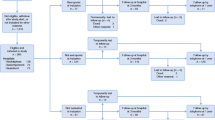Abstract
Background and aims: Although several investigations have tested physical activity a few months or one year after hip fracture, only a few have assessed physical activity shortly after hip fracture. The aim of this study was to evaluate how physical function two weeks after hip fracture operation predicts 12-month mortality. This was a prospective study of hip fracture patients with one-year follow-up, carried out in Jyväskylä Central Hospital in Finland. Methods: In this study, there were 243 consecutive community-dwelling patients aged 65 or older, who were able to walk before hip fracture. Two weeks after operation, information was gathered on pre-fracture activities of daily living (ADLs) and instrumental activities of daily living (IADLs). Patients’ ability to stand up, sit down and walk was assessed. The follow-up lasted 12 months. Results: The best predictor for mortality after one year was inability to stand up, hazard ratio (HR) 4.64 (95% CI 2.11–10.18, p<0.001). The corresponding HRs concerning inability to sit down were 4.52 (95% CI 2.10–9.72, p<0.001), inability to walk 2.39 (95% CI 1.20–4.78, p=0.013), ADL score 1.43 (95% CI 1.16–1.76, p=0.001) and IADL score 1.19 (95% CI 1.03–1.38, p=0.017). These variables were age- and sex-adjusted. According to the multiple proportional hazard model there was only one variable with statistical significance, i.e., the pre-fracture ADL-score (p=0.025). Conclusion: Inability to stand up, sit down or walk two weeks after operation were the strongest predictors for mortality among operated hip fracture patients. We suggest that focus should be directed to verify if better survival might be achieved by more intensive rehabilitation immediately after the operation. The pre-fracture ADL-score appeared to be the only variable reaching statistical significance in the multiple proportional hazard model. This fact may reflect frailty and affect decisions concerning the rehabilitation program.
Similar content being viewed by others
References
Marottoli RA, Berkman LF, Cooney LM. Decline in physical function following hip fracture. J Am Geriatr Soc 1992; 40: 861–6.
Folman Y, Gepstein R, Assart A, Liberty S. Functional recovery after operative treatment of femoral neck fractures in an institutionalized elderly population. Arch Phys Med Rehabil 1994; 75: 454–6.
Broos PLO, Van Haaften KIK, Stappaerst KH, Gruwez J.A. Hip fractures in elderly. Mortality, functional results and social readaptation. Int Surg 1989; 74: 191–4.
Finsen V, Borset M, Rossvoll I. Mobility, survival and nursing-home requirements after hip fracture. Ann Chir Gynaecol 1995; 84: 291–4.
Holmberg S. Agger E. Ersmark H. Rehabilitation at home after hip fracture. Acta Orthop Scand 1989; 60: 73–6.
Aharonoff GB, Koval KJ, Skovron Ml, Zuckerman JD. Hip fractures in the elderly: predictors of one year mortality. J Orthop Trauma 1997; 11: 162–5.
Gree M, Colin L, Soscolne CL, Belseck E, et al. Mortality and institutionalization following hip fracture. J Am Geriatr Soc 2000; 48: 283–8.
Holmberg S, Conradi P, Ragnar K, Thorngren K-G. Mortality after cervical hip fracture. Acta Orthop Scand 1986; 57: 8–11.
Meyer HE. Trevdal A. Falch JA. Pedersen JI. Factors associated with mortality after hip fracture. Osteoporos Int 2000; 11: 228–32.
Imura K, Ishii Y, Yagisawa K, Matsueda M. Postoperative ambulatory level after hip fracture in the elderly predicts survival rate. Arch Orthop Trauma Surg 2000; 120: 369–71.
Fox KM, Hawkes WG, Hebel JR, et al. Mobility after hip fracture predicts health outcomes. J Am Geriatr Soc 1998; 46: 169–73.
Huusko TM, Karppi P, Avikainen V, Kautiainen H, Sulkava R. Intensive geriatric rehabilitation of hip fracture patients. Acta Orthop Scand 2002; 73: 425–31.
Huusko TM, Karppi P, Avikainen V, Kautiainen H, Sulkava R. Randomised, clinical trial of intensive geriatric rehabilitation in patients with hip fracture: subgroup analysis of patients with dementia. BMJ 2000; 321: 1107–11.
Katz S, Ford AB, Moskowitz RW, Jackson BA, Jaffe MW. Studies of illness in the aged. The index of ADL: a standardized measure of biological and psychosocial function. JAMA 1963; 185: 914–9.
Katz S, Downs TD, Cash HR, Grotz RC. Progress in the development of index of ADL. Gerontologist 1970; 1: 20–30.
Lawton MP, Brody EM. Assessment of older people: self-maintaining and instrumental activities of daily living. Gerontologist 1969; 9: 179–86.
Folstein MF, Folstein SE, Mchugh PR. Mini-Mental State: A practical method for grading the cognitive stage of patients for the clinician. J Psychiatr Res 1975; 12: 189–98.
Galvard H, Elmstahl S, Elmstahl B, Samuelsson SM, Roberts-son E. Differences in body composition between female geriatric hip fracture patients and healthy controls: body fat is more important as explanatory factor for the fracture than body weight and lean body mass. Aging Clin Exp Res 1996; 8: 282–6.
Jette AM, Harris BA, Cleary PD, Campion EW. Functional recovery after hip fracture. Arch Phys Med Rehabil 1987; 68: 735–9.
Magaziner J, Simonsick EM, Kashner TM, Hebel JR, Kenzora JE. Predictors of functional recovery one year following hospital discharge for hip fracture: a prospective study. J Gerontol 1990; 3: M101–7.
Covinsky KE, Palmer RM, Counsell SR, Pine ZM, Walter LC, Chren M-M. Functional status before hospitalization in acutely ill older adults: validity and clinical importance of retrospective reports. J Am Geriatr Soc 2000; 48: 164–9.
Mossey JM, Mutran E, Knott K, Craik R. Determinants of recovery12 months after hip fracture: the importance of psychosocial factors. Am J Public Health 1989; 79: 279–86.
Johansson C, Skoog I. A population-based study on the association between dementia and hip fractures in 85-year olds. Aging Clin Exp Res 1996; 8: 189–96.
Schwab M, Roder F, Aleker T, et al. Psychotropic drug use, falls and hip fracture in the elderly. Aging Clin Exp Res 2000; 12; 234–9.
Author information
Authors and Affiliations
Corresponding author
Rights and permissions
About this article
Cite this article
Heinonen, M., Karppi, P., Huusko, T. et al. Post-operative degree of mobilization at two weeks predicts one-year mortality after hip fracture. Aging Clin Exp Res 16, 476–480 (2004). https://doi.org/10.1007/BF03327405
Received:
Accepted:
Published:
Issue Date:
DOI: https://doi.org/10.1007/BF03327405




